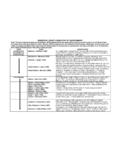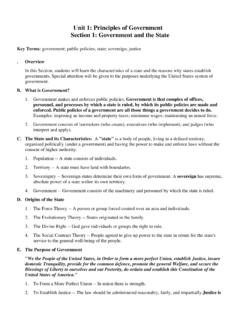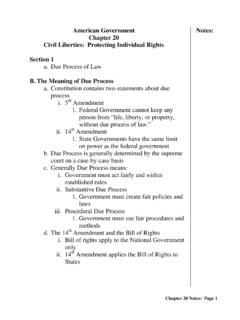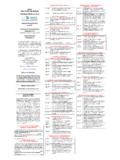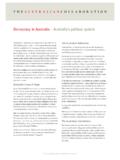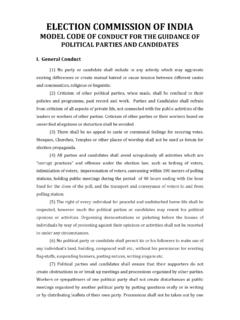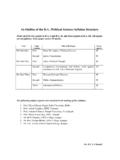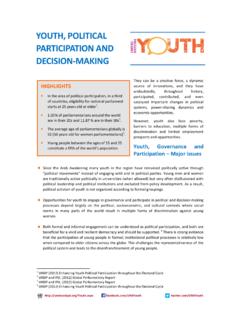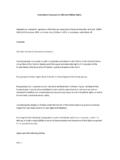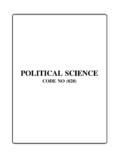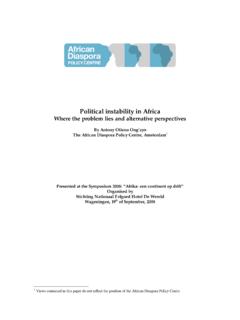Transcription of POLITICAL BELIEFS AND POLITICAL BEHAVIORS
1 1 AMERICAN DEMOCRATIC VALUES Although the United States is a diverse society, it is united under a common POLITICAL culture, or common set of BELIEFS and attitudes about government and politics. This POLITICAL culture translates into a consensus of basic concepts that support democracy. Democracy is not guaranteed; therefore the American people must continue to practice these concepts. majority rule/minority rights: Although democracy is based upon majority rule, minority rights must be guaranteed. equality: Equality of every individual before the law and in the POLITICAL process. private property: Ownership of property is protected by law and supported by the capitalist system. individual freedoms: Guarantees of civil liberties and protections of infringements upon them. compromise: Allows for the combining of different interests and opinions to form public policy to best benefit society.
2 Limited government: Powers of government are restricted in a democracy by the will of the people and the law. POLITICAL SOCIALIZATION POLITICAL socialization is the process by which citizens acquire a sense of POLITICAL identity. Socialization is a complex process that begins early in childhood and continues throughout a person's life. It allows citizens to become aware of politics, learn POLITICAL facts, and form POLITICAL values and opinions. Although the paths to POLITICAL awareness, knowledge, and values differ, people are exposed to a combination of influences that shape their POLITICAL identities and opinions: Family and home influences often help shape POLITICAL party identification. It is strongest when both parents identify with the same POLITICAL party. Schools teach patriotism, basic governmental functions and structure, and encourage POLITICAL participation.
3 Group affiliations (interest groups, labor unions, professional organizations) provide common bonds between people which may be expressed through the group or its activities. Demographic factors (occupation, race, gender, age, religion, region of country, income, education, ethnicity). Mass media inform the public about issues and help set the POLITICAL and public agendas. Opinion leaders, those individuals held in great respect because of their position, expertise, or personality, may informally and unintentionally exercise influence. Events may instill positive or negative attitudes. For example, the Watergate scandal created a mistrust of government. PUBLIC OPINION Public opinion is a collection of shared attitudes of many different people in matters relating to politics, public issues, or the making of public policy. It is shaped by people's POLITICAL culture and POLITICAL socialization.
4 Public opinion can be analyzed according to distribution (physical shape of responses when graphed), intensity (how strongly the opinions are held), and stability (how much the opinion changes over time). A consensus occurs when there is general agreement on an issue. Public opinion that is strongly divided between two very different views is a divisive opinion. Measuring Public Opinion The measurement of public opinion is a complex process often conveying unreliable results. Elections, interest groups, the media, and personal contacts may signal public opinion on certain issues; however, the most reliable measure of public opinion is the public opinion poll. Businesses, governments, POLITICAL candidates, and interest groups use polls. Early polling in the United States involved the use of straw polls, asking the same question of a large number of people. They were unreliable because they did not necessarily include a cross-section of the general population of the United States.
5 The most famous mishap occurred in 1936 when the Literary Digest mailed postcards to more than 10 million people concerning the outcome of the 1936 presidential election. With over 2 million responses, the magazine incorrectly predicted the defeat of Franklin Roosevelt and victory of challenger Alf Landon. The magazine had used automobile registrations and telephone directories to develop its sample, not realizing that during the Depression many people did not have cars or telephones. Many voters who supported Roosevelt had not been polled. The mailings had also been done early, and some voters changed their minds between answering the poll and actually voting. Modern polling began in the 1930s when George Gallup helped develop the use of a scientific polling process that includes: Sampling - Those chosen to participate in the poll must be representative of the general population and chosen at random.
6 Preparing valid questions - Directions should be clear and questions should be phrased and ordered in a way that does not lead the respondent to a particular answer (dear, fair, and unbiased). POLITICAL BELIEFS AND POLITICAL BEHAVIORS 2 Controlling how the poll is taken - Make sure the respondent has some knowledge of the issues addressed in the poll and that the pollster's appearance and tone do not influence the responses. Survey methods may include telephone, mail, and in-person interviews. Analyzing and reporting results - Reporting the results of polls without providing information about how the poll was conducted, sampling errors, or when the poll that was taken can lead to misinformation and error. Today, the use of statistical analysis through computers has made polling an even more accurate research tool. Ideology An ideology is a consistent set of BELIEFS .
7 A POLITICAL ideology is a set of BELIEFS about politics and public policy that creates the structure for looking at government and public policy. POLITICAL ideologies can change over time. Differences in ideology generally occur in the arena of POLITICAL , economic, and social issues. Ideology: A POLITICAL Spectrum radical: favors rapid, fundamental change in existing social, economic, or POLITICAL order; may be willing to resort to extreme means, even violence or revolution to accomplish such change (extreme change to create an entirely new social system) liberal: supports active government in promoting individual welfare and supporting civil rights, and accepts peaceful POLITICAL and social change within the existing POLITICAL system moderate: POLITICAL ideology that falls between liberal and conservative and which may include some of both; usually thought of as tolerant of others' POLITICAL opinions and not likely to hold extreme views on issues conservative: promotes a limited governmental role in helping individuals economically, supports traditional values and lifestyles, favors a more active role for government in promoting national security, and approaches change cautiously reactionary.
8 Advocates a return to a previous state of affairs, often a social order or government that existed earlier in history (may be willing to go to extremes to achieve their goals) PARTICIPATION AND VOTING Forms of POLITICAL Participation voting in elections discussing politics and attending POLITICAL meetings forming interest groups and PACS contacting public officials campaigning for a candidate or POLITICAL party contributing money to a candidate or POLITICAL party running for office protesting government decisions Most of these BEHAVIORS would be considered conventional or routine, within the acceptable channels of representative government. Less conventional BEHAVIORS have been used when groups have felt powerless and ineffective. Although Americans are less approving of unconventional BEHAVIORS , those tactics are sometimes effective in influencing government decisions.
9 The often-violent protests against the Vietnam Conflict discouraged Lyndon Johnson from running for reelection in 1968. The most common form of POLITICAL participation in the United States is voting. However, Americans are less likely to vote than citizens of other countries. Participation Through Voting Democratic government is "government by the people." In the United States, participation through elections is the basis of the democratic process. According to democratic theory, everyone should be allowed to vote. In practice, however, no nation grants universal suffrage; all nations have requirements for voting. Expansion of Suffrage Suffrage is the right to vote. It is a POLITICAL right that belongs to all those who meet certain requirements set by law. The United States was the first nation to provide for general elections of representatives through mass suffrage.
10 The issue of suffrage is left to the states the only stipulation found in Article 1, Section 2 of the Constitution is that individuals who could vote for "the most numerous branch of the state legislature" could also vote for their Congressional representatives. The composition of the American electorate has changed throughout history. Two major trends have marked the development of suffrage: the elimination of a number of restrictive requirements and the transfer of more and more authority from the states to the federal government. 3 Changes in voting requirements have included: elimination of religious qualifications, property ownership, and tax payments after 1800 elimination of race disqualifications with the passage of the 15th Amendment in 1870 elimination of gender disqualifications with the passage of the 19th Amendment in 1920 elimination of grandfather clauses, white primaries, and literacy requirements with the, passage of federal civil rights legislation and court decisions (Civil Rights Acts, Voting Rights Act of 1965) allowing residents of Washington, , to vote in presidential elections with the passage of the 23rd Amendment in 1961 elimination of poll taxes in federal elections with the passage of the 24th Amendment in 1964 (all poll taxes were ruled unconstitutional in Harper v.)
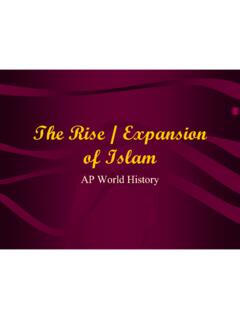
![Europe in the Postclassical Era.ppt [Read-Only]](/cache/preview/3/f/0/5/a/f/4/a/thumb-3f05af4abb01b691e0d84337014c46bf.jpg)
